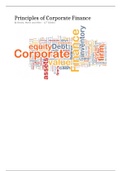Summary
Principle of Corporate Finance Book Lectures Tutorials summary
- Course
- Institution
- Book
This is my handwritten summary that made me pass this course with an 8 with ease. It contains: - all the mandatory chapters from the book - some self-written bonus explanations to clarify difficult matters. - tips and tricks from the tutorial sessions I also made sure that what was written in...
[Show more]





